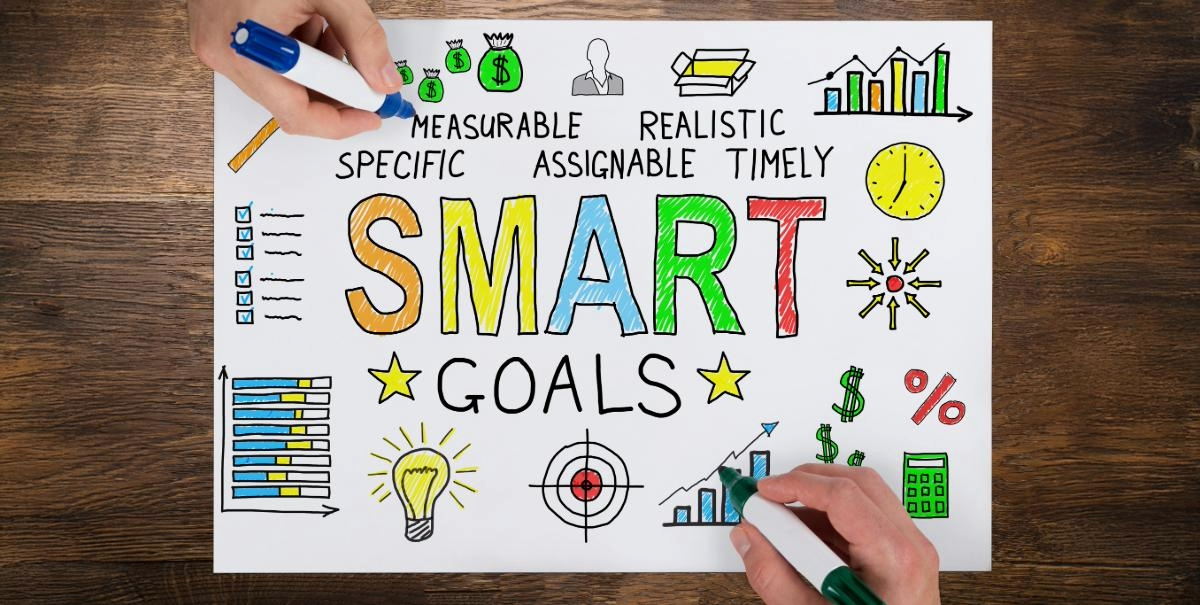The Power of Strategic Goal Setting
The new year is a time when many individuals and organizations alike turn their attention to the art of goal setting. However, not all goal-setting practices are created equal. Strategic goal setting, a methodical and thoughtful approach to defining and achieving objectives, has emerged as a powerful tool for personal and professional growth.
Strategic goal setting goes beyond mere wishful thinking or vague resolutions. It involves a systematic process of identifying, prioritizing, and planning for the outcomes that matter most. This approach recognizes that success is rarely accidental; rather, it is the result of careful deliberation, focused effort, and consistent action. By embracing strategic goal setting, individuals and teams can chart a clear course towards their desired future, maximizing their chances of turning aspirations into tangible achievements.
The benefits of strategic goal setting are manifold. It provides clarity and direction, helping to focus resources and energy on what truly matters. It also serves as a motivational force, inspiring individuals to push beyond their comfort zones and strive for continuous improvement. Moreover, strategic goals act as a benchmark against which progress can be measured, allowing for timely adjustments and celebrations of milestones along the way.
Understanding the Psychology Behind New Year’s Resolutions
The tradition of making New Year’s resolutions dates back thousands of years, with ancient Babylonians believed to be among the first to engage in this practice. Today, it remains a widespread custom, with millions of people worldwide using the turn of the calendar as a catalyst for personal change. However, despite the best intentions, many resolutions fall by the wayside within weeks or months.
The psychology behind New Year’s resolutions is complex and multifaceted. The start of a new year represents a temporal landmark, a fresh slate that psychologically separates the past from the future. This perception of a new beginning can be incredibly motivating, fueling optimism and a sense of possibility. It taps into the human desire for self-improvement and the belief that change is possible.
However, the very factors that make New Year’s resolutions appealing can also contribute to their downfall. The excitement of a fresh start can lead to overly ambitious or unrealistic goals. Additionally, the external pressure to set resolutions may result in commitments that are not truly aligned with an individual’s values or intrinsic motivations. Understanding these psychological underpinnings is crucial for transforming well-intentioned resolutions into sustainable, strategic goals that have a higher likelihood of success.
Key Components of a Successful Goal Setting Framework
A robust goal-setting framework is essential for translating aspirations into actionable plans. Several key components contribute to the effectiveness of such a framework:
- Clarity and Specificity: Goals should be clearly defined and specific, leaving no room for ambiguity. This precision helps in visualizing the end result and planning the necessary steps to achieve it.
- Measurability: Incorporating quantifiable metrics allows for tracking progress and determining when a goal has been achieved. This element of measurability provides objective feedback and motivation.
- Relevance and Alignment: Goals should be relevant to one’s overall vision and aligned with personal or organizational values. This alignment ensures that the pursuit of goals contributes meaningfully to long-term aspirations.
- Time-Bound Nature: Setting deadlines creates a sense of urgency and helps in prioritizing efforts. It also allows for the creation of milestones and checkpoints along the way.
- Flexibility: While goals should be challenging, they should also be adaptable to changing circumstances. A degree of flexibility allows for adjustments without abandoning the overall objective.
By incorporating these components into a goal-setting framework, individuals and organizations can create a solid foundation for success. This structure not only enhances the likelihood of achieving desired outcomes but also provides a roadmap for navigating the journey towards those goals.
SMART Goals: A Time-Tested Approach
The SMART goal-setting framework has stood the test of time as an effective methodology for creating meaningful and achievable objectives. SMART is an acronym that stands for Specific, Measurable, Achievable, Relevant, and Time-bound. This approach provides a structured way to define goals that are clear, trackable, and aligned with broader objectives.
Let’s break down each component of the SMART framework:
- Specific: Goals should be well-defined and focused. Instead of a vague goal like “improve fitness,” a specific goal might be “run a 5K race.”
- Measurable: Include criteria for measuring progress. For the 5K goal, measurable elements could include running distance, time, or frequency of training sessions.
- Achievable: Goals should be challenging yet attainable. Consider current capabilities and resources when setting goals.
- Relevant: Ensure that the goal aligns with broader life or career objectives. The 5K goal, for instance, should fit into an overall health and wellness plan.
- Time-bound: Set a clear timeframe for achieving the goal. This could be “complete a 5K race within six months.”
The SMART framework helps transform abstract desires into concrete plans. It forces individuals to think critically about their objectives and creates a roadmap for achievement. By applying this methodology, goal-setters can increase their chances of success and maintain motivation throughout the process.
The Importance of Aligning Personal and Professional Goals
In today’s interconnected world, the lines between personal and professional lives are increasingly blurred. Recognizing this reality, successful goal-setting strategies often emphasize the importance of aligning personal and professional objectives. This alignment can lead to greater satisfaction, improved work-life balance, and enhanced overall performance.
When personal and professional goals are in harmony, individuals are more likely to experience a sense of fulfillment and purpose in both spheres of their lives. For example, a professional goal of advancing to a leadership position might align with a personal goal of developing better communication skills. By working on these skills, an individual can simultaneously progress in their career and improve their personal relationships.
Moreover, this alignment can lead to increased motivation and energy. When professional pursuits support personal values and aspirations, work becomes more meaningful and engaging. Conversely, personal growth can contribute to professional success, creating a positive feedback loop that drives continuous improvement.
To achieve this alignment, individuals should:
- Reflect on core values and long-term aspirations
- Identify areas of overlap between personal and professional interests
- Seek opportunities that allow for growth in both areas
- Regularly reassess and adjust goals to maintain alignment
By consciously aligning personal and professional goals, individuals can create a more holistic and satisfying approach to goal setting, leading to greater success and well-being in all aspects of life.
Breaking Down Long-Term Goals into Actionable Steps
Long-term goals can often seem daunting and overwhelming, potentially leading to procrastination or abandonment. The key to overcoming this challenge lies in breaking down these ambitious objectives into smaller, manageable tasks. This process, known as goal decomposition, not only makes the overall goal seem more achievable but also provides a clear roadmap for progress.
Here’s a step-by-step approach to breaking down long-term goals:
- Identify the End Goal: Clearly define the ultimate objective you wish to achieve.
- Determine Major Milestones: Identify significant checkpoints that mark substantial progress towards the end goal.
- Create Sub-Goals: Break each milestone into smaller, specific sub-goals.
- Define Action Steps: For each sub-goal, list concrete actions that need to be taken.
- Assign Timelines: Allocate realistic timeframes for completing each action step and sub-goal.
This hierarchical approach to goal setting allows for a more structured and manageable pursuit of long-term objectives. It provides a sense of progress as smaller tasks are completed, maintaining motivation and momentum. Additionally, this method allows for easier tracking of progress and identification of potential obstacles or areas needing adjustment.
Consider using tools like mind maps, Gantt charts, or project management software to visualize and organize the breakdown of goals. These visual aids can help in understanding the relationship between different tasks and maintaining a clear overview of the entire goal-achievement process.
Leveraging Technology for Goal Tracking and Management
In the digital age, a plethora of technological tools are available to assist in goal tracking and management. These tools can significantly enhance the goal-setting process by providing organization, reminders, progress tracking, and data analysis. Leveraging technology effectively can increase the likelihood of goal achievement and provide valuable insights into personal or organizational performance.
Some popular categories of goal-tracking technologies include:
- Mobile Apps: Applications like Todoist, Trello, or Asana offer task management and goal-tracking features accessible from smartphones.
- Habit Trackers: Apps such as Habitica or Streaks gamify the process of building habits aligned with goals.
- Project Management Software: Tools like Microsoft Project or Basecamp are useful for complex, multi-faceted goals.
- Wearable Devices: Fitness trackers and smartwatches can help monitor health and wellness goals.
- AI-Powered Assistants: Virtual assistants like Siri or Google Assistant can set reminders and help manage schedules.
When selecting a technological tool for goal management, consider factors such as:
- User interface and ease of use
- Integration with other tools and platforms
- Customization options
- Data visualization and reporting features
- Collaboration capabilities (if working in a team)
While technology can be a powerful ally in goal achievement, it’s important to remember that it should serve as a support system rather than a substitute for personal commitment and effort. The most effective approach often combines technological tools with traditional goal-setting methodologies and personal accountability.
Overcoming Common Goal Setting Pitfalls
Even with the best intentions and a solid framework, goal setting can sometimes fall short due to common pitfalls. Recognizing and addressing these challenges is crucial for maintaining momentum and achieving desired outcomes. Here are some frequent obstacles and strategies to overcome them:
- Setting Unrealistic Goals:
- Solution: Use the SMART framework to ensure goals are achievable and grounded in reality.
- Conduct thorough research and self-assessment before setting ambitious targets.
- Lack of Clarity:
- Solution: Clearly define goals and expected outcomes.
- Create a detailed action plan with specific steps and milestones.
- Insufficient Motivation:
- Solution: Connect goals to personal values and long-term vision.
- Visualize the benefits and positive impact of achieving the goals.
- Procrastination:
- Solution: Break down goals into smaller, manageable tasks.
- Use time management techniques like the Pomodoro method to maintain focus.
- Lack of Accountability:
- Solution: Share goals with a trusted friend, mentor, or coach.
- Join or create a support group of like-minded individuals pursuing similar goals.
- Neglecting to Review and Adjust:
- Solution: Schedule regular check-ins to assess progress and make necessary adjustments.
- Be flexible and willing to modify goals as circumstances change.
- Overcommitment:
- Solution: Prioritize goals and focus on a few key objectives at a time.
- Learn to say no to commitments that don’t align with current priorities.
By anticipating these common pitfalls and implementing strategies to address them, individuals can significantly increase their chances of success in goal achievement. Remember that setbacks are a normal part of the process and can provide valuable learning opportunities for future goal-setting endeavors.
The Role of Accountability in Achieving Your Goals
Accountability plays a crucial role in the goal achievement process, serving as a powerful motivator and a safeguard against procrastination and abandonment. When individuals hold themselves accountable or are held accountable by others, they are more likely to stay committed to their goals and take consistent action towards achieving them.
There are several ways to incorporate accountability into the goal-setting process:
- Personal Accountability: This involves developing self-discipline and internal motivation. Strategies include:
- Keeping a journal to track progress and reflect on challenges
- Setting personal deadlines and consequences for missing them
- Regularly reviewing and updating goals
- Accountability Partners: Partnering with a friend, colleague, or mentor can provide external motivation and support. Benefits include:
- Regular check-ins to discuss progress and obstacles
- Mutual encouragement and celebration of achievements
- Shared experiences and problem-solving
- Public Commitments: Sharing goals publicly can create a sense of social accountability. Options include:
- Announcing goals on social media or personal blogs
- Joining online communities focused on similar goals
- Participating in group challenges or competitions
- Professional Coaching: Working with a professional coach or counselor can provide structured accountability and expert guidance. Advantages include:
- Tailored strategies for overcoming obstacles
- Objective feedback and perspective
- Access to specialized knowledge and resources
- Technology-Assisted Accountability: Leveraging apps and devices that track progress and send reminders can help maintain focus. Examples include:
- Goal-tracking apps with notification features
- Fitness trackers for health-related goals
- Project management tools for work-related objectives
Incorporating accountability measures into the goal-setting process not only increases the likelihood of success but also provides valuable support and motivation throughout the journey. It’s important to choose accountability methods that align with personal preferences and the nature of the goals being pursued.
Celebrating Milestones: Staying Motivated Throughout the Year
Maintaining motivation over the long haul is crucial for achieving ambitious goals. One effective strategy for sustaining enthusiasm and commitment is the celebration of milestones along the way. These celebrations serve multiple purposes: they provide a sense of accomplishment, reinforce positive behaviors, and create momentum for tackling the next phase of the goal.
Here are some approaches to effectively celebrate milestones:
- Define Clear Milestones: Break down larger goals into smaller, measurable achievements that can be celebrated.
- Plan Rewards in Advance: Determine appropriate rewards for each milestone, ensuring they are meaningful and proportionate to the achievement.
- Vary Celebration Styles: Mix up the ways you celebrate to keep things interesting. Options might include:
- Personal treats (e.g., a spa day, a favorite meal)
- Social celebrations (e.g., dinner with friends, a group outing)
- Professional recognition (e.g., sharing achievements with colleagues)
- Reflect on Progress: Use milestone celebrations as an opportunity to reflect on the journey so far, acknowledging challenges overcome and lessons learned.
- Share Achievements: Consider sharing your progress with your support network or on social media to receive encouragement and inspire others.
- Align Celebrations with Goals: Ensure that celebration activities don’t undermine the goals themselves. For instance, celebrate a fitness milestone with a new workout gear rather than an indulgent meal.
- Create a Visual Representation: Use a vision board, progress chart, or digital tracker to visually represent milestones achieved, providing a tangible reminder of progress.
By intentionally celebrating milestones, individuals can maintain a positive mindset, boost self-confidence, and stay motivated to pursue their goals throughout the year. This practice transforms the goal-achievement process from a daunting task into a series of rewarding experiences, making the journey as fulfilling as the destination.
Adapting Your Goals: Flexibility in the Face of Change
In an ever-changing world, the ability to adapt goals is as crucial as setting them in the first place. Life’s unpredictability, shifting priorities, and unforeseen circumstances can all impact the relevance and achievability of previously set goals. Embracing flexibility in goal setting allows individuals and organizations to remain resilient and effective in the face of change.
Key strategies for maintaining flexibility in goal setting include:
- Regular Review and Assessment: Schedule periodic evaluations of goals to ensure they remain aligned with current circumstances and priorities.
- SWOT Analysis: Conduct Strengths, Weaknesses, Opportunities, and Threats analyses to identify potential areas for goal adjustment.
- Scenario Planning: Anticipate potential changes and develop contingency plans for different scenarios.
- Incremental Goal Setting: Break long-term goals into shorter-term objectives that can be more easily adjusted as needed.
- Maintain a Growth Mindset: View challenges and changes as opportunities for learning and growth rather than setbacks.
- Embrace Pivot Strategies: Be prepared to shift focus or direction when circumstances warrant, without abandoning overall objectives.
- Seek Feedback: Regularly solicit input from mentors, colleagues, or stakeholders to gain diverse perspectives on goal progress and relevance.
Adapting goals doesn’t mean compromising on ambition or giving up at the first sign of difficulty. Instead, it involves a thoughtful recalibration based on new information or changing circumstances. This approach ensures that goals remain relevant, achievable, and aligned with evolving personal or organizational needs.
Case Studies: Success Stories of Strategic Goal Setting
Examining real-world examples of successful goal setting can provide valuable insights and inspiration. The following case studies illustrate the power of strategic goal setting across various domains:
- Corporate Success: Amazon’s Long-Term Vision
- Goal: Become the world’s most customer-centric company
- Strategy: Jeff Bezos implemented a long-term thinking approach, focusing on customer satisfaction over short-term profits
- Outcome: Amazon became one of the world’s most valuable companies, revolutionizing e-commerce and cloud computing
- Personal Achievement: J.K. Rowling’s Writing Journey
- Goal: Complete and publish the Harry Potter series
- Strategy: Set daily writing goals and persevered through numerous rejections
- Outcome: Created one of the best-selling book series in history, transforming her life and the publishing industry
- Health and Fitness: Chris Pratt’s Physical Transformation
- Goal: Get in shape for a leading role in “Guardians of the Galaxy”
- Strategy: Set specific fitness targets, worked with trainers, and maintained a strict diet
- Outcome: Lost over 60 pounds in six months, leading to a career-defining role
- Environmental Impact: Patagonia’s Sustainability Goals
- Goal: Minimize environmental impact while maintaining a successful business
- Strategy: Implemented sustainable practices, including using recycled materials and donating 1% of sales to environmental causes
- Outcome: Became a leader in corporate sustainability while growing its brand and customer base
- Educational Achievement: Malala Yousafzai’s Advocacy for Girls’ Education
- Goal: Ensure access to education for girls worldwide
- Strategy: Used her platform to raise awareness, established the Malala Fund, and continued her own education
- Outcome: Became the youngest Nobel Prize laureate and a global advocate for education rights
These case studies demonstrate that strategic goal setting, combined with perseverance and adaptability, can lead to remarkable achievements across various fields. They highlight the importance of clarity, commitment, and the willingness to overcome obstacles in pursuit of significant goals.
Conclusion: Your Roadmap to a Successful New Year
As we conclude this exploration of strategic goal setting, it’s clear that the journey towards achievement is as important as the destination itself. The process of setting and pursuing goals is a powerful tool for personal and professional growth, providing direction, motivation, and a framework for measuring progress.
Key takeaways from this discussion include:
- The importance of aligning goals with personal values and long-term vision
- The effectiveness of the SMART goal-setting framework
- The need for breaking down long-term goals into actionable steps
- The role of technology in goal tracking and management
- The significance of accountability and celebration in maintaining motivation
- The value of flexibility and adaptability in the face of change
As you embark on your goal-setting journey for the new year, remember that success is not just about reaching the final destination but also about the growth and learning that occurs along the way. Embrace the process, stay committed to your aspirations, and be open to adjusting your course as needed.Ready to transform your aspirations into achievements? Take the first step towards a more successful you by implementing the strategic goal-setting techniques discussed in this article. Start by identifying your top three priorities for the coming year and apply the SMART framework to each. Remember, the journey of a thousand miles begins with a single step. Your future self will thank you for the goals you set and pursue today. Let’s make this year your most accomplished yet!By approaching goal setting with strategy, commitment, and flexibility, you create a powerful roadmap for success.





